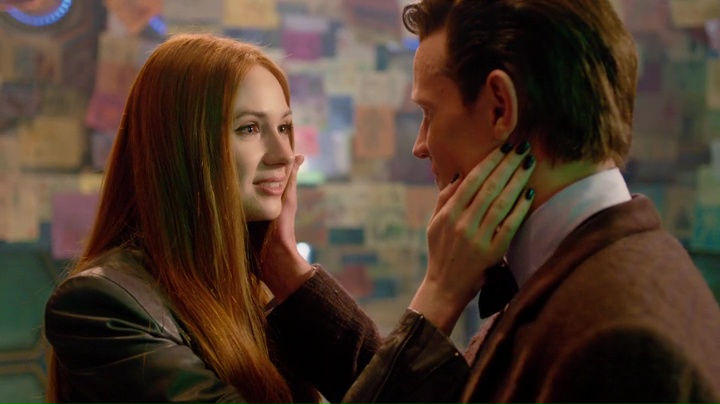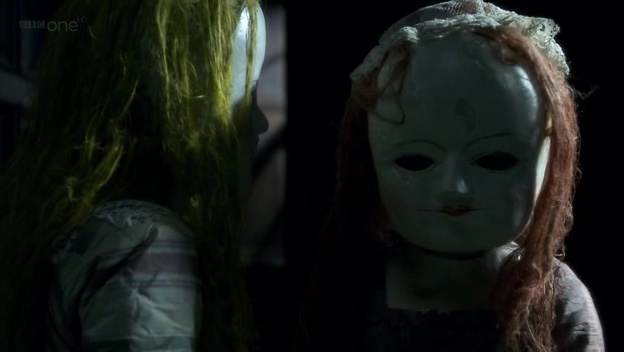Creature from the Black Lagoon
 Last week we talked about the expression of the Beautiful throughout the history of Doctor Who, and gleaned different kinds of aesthetics employed by the show in the process – from awe at new, strange places… to the banal objectification of women… to an almost ritualized praise of monsters in the modern era. And it’s this latter sense of beauty that I find most interesting, given how monsters are now used in Doctor Who, especially in the Moffat era. Because monsters are no longer just villainous plot devices for generating scares. Quite often they are secret protagonists, and weighted with symbolic value, especially when juxtaposed with our main characters such that they become telling metaphors. This latter process I call the “monstering” of a character, and of particular interest to me is how Amy Pond becomes consistently monstered during her time on the show.
Last week we talked about the expression of the Beautiful throughout the history of Doctor Who, and gleaned different kinds of aesthetics employed by the show in the process – from awe at new, strange places… to the banal objectification of women… to an almost ritualized praise of monsters in the modern era. And it’s this latter sense of beauty that I find most interesting, given how monsters are now used in Doctor Who, especially in the Moffat era. Because monsters are no longer just villainous plot devices for generating scares. Quite often they are secret protagonists, and weighted with symbolic value, especially when juxtaposed with our main characters such that they become telling metaphors. This latter process I call the “monstering” of a character, and of particular interest to me is how Amy Pond becomes consistently monstered during her time on the show.
But what does it mean “to be monstered?” What does that look like? And how unique is it to the modern era? To answer those questions, I’ll step briefly back into the past, to The Android Invasion, aa 4th Doctor story with Sarah Jane in Season 13. In The Android Invasion the Doctor and Sarah Jane have landed on an alien planet that looks like Earth, but it isn’t Earth, it’s the staging ground for an alien invasion that will use android duplicates of certain Earthlings, which is pretty standard Doctor Who fare when you think of it. Anyways, there’s this great cliffhanger where Sarah Jane has been replaced by an android duplicate, only the Doctor has figured it out and attacks her, wrestling her to the ground. Her face falls off, revealing so much circuitry.
Yes, this the best moment in the otherwise fairly dreadful tale (it was written by Terry Nation, for gods’ sakes), but it’s also freighted with some potentially interesting literary readings. First of all, Sarah Jane isn’t the only android duplicate – there’s some regular UNIT personnel, and even the Doctor, all monstered by androids. It’s uncanny because we see characters we’ve known as “good” behaving in ways that are “not good,” which is rather transgressive. Aside from that, though, there’s the opportunity for the nature of the particular monster to inform us about our characters’ natures. This works particularly well in the monstering of Benton and Harry – they’re programmatic characters. Sadly, Terry Nation is not a particularly writerly writer, as the monstering of both the Doctor and Sarah Jane really don’t say much about them at all – well, unless we stretch it a bit. For example, Sarah Jane’s role as a Companion is often programmatic, from assisting in asking questions for the audience to serving as a plot device. And even the Doctor, well, it’s a role that could be (and has been) played by all kinds of performers, such that he doesn’t even have a real face anymore.
 Contrast this with the monstering of Amy in Night Terrors. In Night Terrors, we see Amy transformed into a deadly Wooden Doll, the product of a child’s nightmare, a child who’s afraid of being abandoned. …
Contrast this with the monstering of Amy in Night Terrors. In Night Terrors, we see Amy transformed into a deadly Wooden Doll, the product of a child’s nightmare, a child who’s afraid of being abandoned. …
